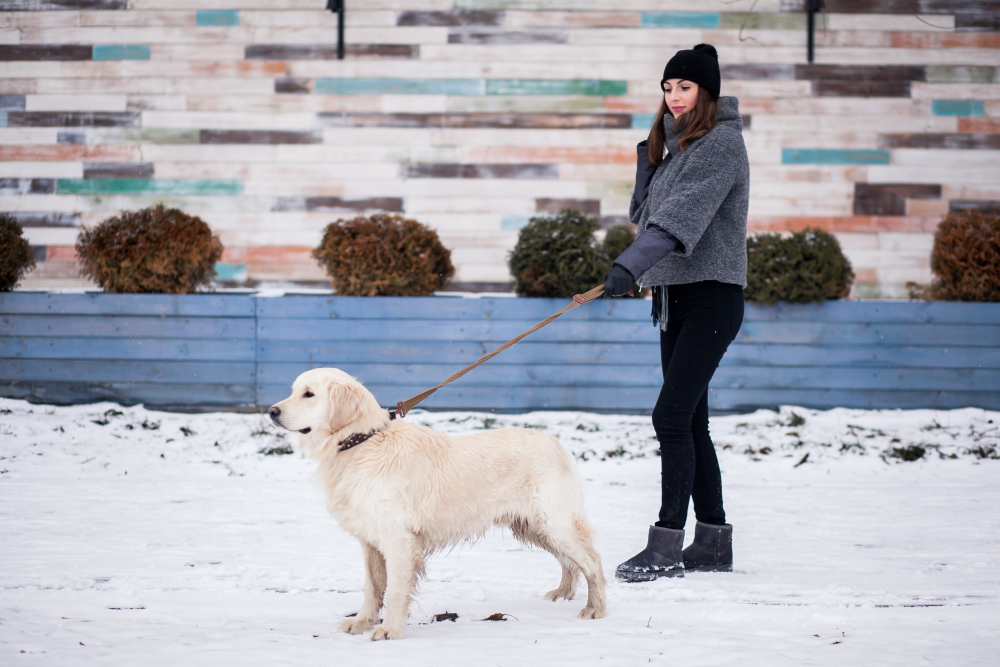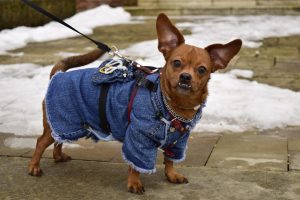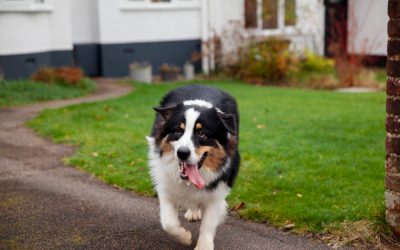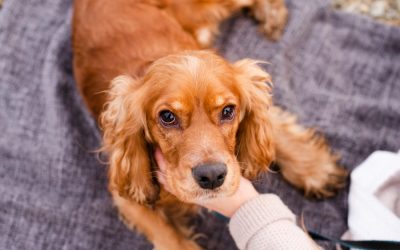Thanksgiving Activities: How to Keep Your Dog Active

Thanksgiving and the holiday season are a great chance to engage our pets in fun, beneficial activities. This article will explore safe and fun Thanksgiving indoor and outdoor activities for dogs.
Safe Outdoor Activities for Dogs on Thanksgiving Day
Thanksgiving’s crisp air and vivid colors are perfect for outdoor adventures with your dog.
Walking and Hiking
A leisurely stroll or a challenging hike is a great way to spend time with your dog and enjoy the beauty of the season. This activity gives your dog exercise and lets them explore new sights, sounds, and smells, stimulating their senses and enriching their minds.
However, weather significantly influences the duration your dog can spend outdoors and whether your dog will need protective clothing, such as coats. This impact is contingent on factors like temperature, weather, breed, and, most importantly, your dog’s health. Here’s a comprehensive guide on how weather affects outdoor time for dogs and when to consider using a coat:
Cold Weather Considerations
Temperature Sensitivity
- Small, short-haired, or thin-coated breeds are sensitive to cold. Chihuahuas, Greyhounds, and Dachshunds, for example, may need coats or sweaters when it drops below 45°F (7°C).
- Arctic breeds, such as huskies and mummies, can handle colder temperatures without extra protection, but it’s still important to be cautious in extreme cold.
- Puppies, senior dogs, and sick dogs are vulnerable to the cold. Limit their outdoor time in chilly weather and use proper clothing to keep them warm.
Outdoor Time
- Above freezing (32°F/0°C): Most dogs can tolerate some outdoor time, but sensitive breeds such as Chihuahuas, Greyhounds, Whippets, and Italian Greyhounds, as well as Toy Breeds such as Pomeranians, Yorkshire Terriers, Bichon Frises, and Maltese, may need coats. Limit exposure during wet, windy conditions.
- Below Freezing: Limit outdoor time for dogs of all sizes, breeds, and ages, and provide coats if they need to be outside. Frostbite and hypothermia become concerns in extreme cold (20°F/-6°C or lower).
- Wind Chill and Wet Conditions: Wind and rain or snow can make the cold feel more intense. Reduce outdoor time further, even for cold-tolerant breeds.
Proper Coats
- Winter Coats: Use insulated, waterproof coats to protect your dog from the cold, especially in snow or freezing rain.
- Sweaters: For mild cold, a warm sweater or fleece can work and is recommended for indoor-outdoor transitions.
Hot Weather Considerations
Temperature Sensitivity:
- Heat-Sensitive Breeds: Brachycephalic breeds, such as Bulldogs and Pugs, struggle to breathe and cool down in the heat, making them vulnerable to heat exhaustion.
- Dark-Coated and Long-Haired Breeds: Dogs with thick or dark coats can overheat quickly in hot weather.
Outdoor Time
- Above 75°F (24°C): Monitor your dog closely. Reduce activity during peak heat (midday) and prioritize shaded areas.
- Above 85°F (29°C): Limit outdoor time, especially for exercise. Dogs should be in cooler areas, and it’s best to walk early in the morning or late in the evening. Carry water and take breaks in the shade.
- Above 90°F (32°C): Avoid outdoor activity altogether if possible, as dogs can quickly overheat in extreme temperatures, and paw pads can burn on hot pavement.
Protective Gear
- Cooling Vests and Bandanas: In hot weather, soaked cooling vests and bandanas can help dogs. They work by evaporative cooling.
- Booties: If the pavement is hot, consider using booties to protect your dog’s paws from burns.
Rainy or Windy Weather
- Waterproof Coats: A waterproof coat can keep your dog dry in the rain.
- Limited Time Outdoors: Wind and storms can cause stress and anxiety in some dogs. If this is the case for your pet, limit outdoor time in bad weather.
Playing Fetch
Fetch is a simple yet effective way to burn off your dog’s energy while also strengthening the bond between you.
Visiting a Dog Park
If your local dog park is open on Thanksgiving Day, consider taking your pup for a visit. Dog parks are safe, social places for your dog. They can play with other dogs and run to burn off energy.
You should watch how your dog interacts with other dogs and look for signs of good play. To ensure your pet feels safe, they will likely have relaxed body language, play bows, or move around loosely. If you see any stress or aggression, like growling, stiff posture, or excessive barking, step in calmly and redirect your dog to avoid any problems.
Trail Running
Trail running can be thrilling and rewarding for active dogs and their owners and allows you to burn calories before the Thanksgiving feast. Remember to start slowly and build up stamina gradually to prevent overexertion.
Indoor Exercise Ideas for Dogs During Thanksgiving
Outdoor activities are great for keeping your dog active, but indoor exercise can be just as beneficial when bad weather or other issues arise. If you have lots of family and friends around, they can help entertain your dog with engaging activities. Here are some engaging indoor options to consider:
Indoor Fetch or Tug-of-War
If you have a spacious room or hallway, you can still enjoy a game of fetch or tug-of-war with your dog.
Hide-and-Seek with Treats
Keep your dog mentally stimulated. Play hide-and-seek with their favorite treats. It will challenge their problem-solving skills. Hide treats around the house. Encourage your pup to use their nose to find them. It will be a fun, rewarding experience.
Interactive Puzzle Toys
Invest in interactive puzzle toys designed to challenge your dog’s cognitive abilities. These toys require your dog to manipulate them to release treats. This keeps their minds engaged and prevents boredom.
Recognizing Signs of Overexertion or Stress in Dogs
Physical and mental activities are vital for your dog’s well-being, but watch for signs of overexertion or stress. Watch for excessive panting, slowing down, or reluctance to continue the activity. If you notice any of these signs, give your dog a break, water, and a cool, shaded area to rest.
Common Health Issues During Thanksgiving and the Importance of Pet Insurance
Thanksgiving feasts can be risky for dogs due to the food. Eating rich or fatty foods, chocolate, and other harmful things can cause digestive issues, pancreatitis, or other severe complications. Also, the excitement and routine disruptions of the holiday season can stress some dogs and can cause anxiety.
Consider a good pet insurance plan to ensure your pet gets quick, complete care if they fall ill. Pet insurance can protect you from high vet bills. It lets you focus on your dog’s health without worrying about treatment costs.
What Does Odie Pet Insurance Cover?
Pet insurance covers various veterinary expenses, providing financial protection and peace of mind for pet owners. Here are the details of the coverage options offered by Odie Pet Insurance:
Illness & Injury Plan
The Illness & Injury Plan is an all-inclusive insurance plan designed to cover a wide range of medical needs for your pet. This plan includes comprehensive coverage for various illnesses, injuries, and veterinary services. Some of the covered items include:
- Veterinary exams and consultations
- Diagnostics (e.g., X-rays, lab tests)
- Prescribed medications
- Surgeries and hospitalization
- Rehabilitation, acupuncture, or chiropractic treatments
- Medically necessary supplies
- Euthanasia and cremation
The Wellness Plan
The Wellness Plan is a monthly membership that focuses on preventive care and covers routine veterinary services.
- Provides reimbursements for routine care items such as wellness visits (exams and vaccines), testing and parasite prevention, dental cleanings and at-home dental care, vitamins, supplements, and more.
- Through Odie’s partnership with Petivity, a leader in smart pet products and proactive care, Wellness Plan members can also receive reimbursements for Petivity devices and health kits, as well as eligible Purina food and supplements.
- Total reimbursement up to $700 per year.




